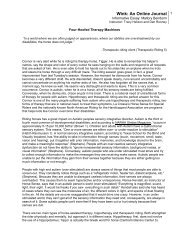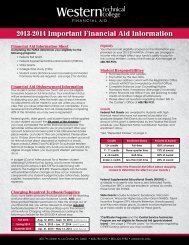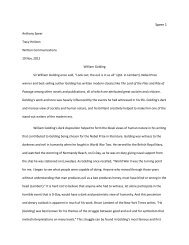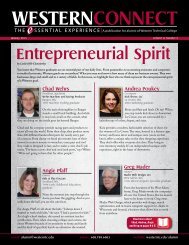Wink: An Online Journal Wal-Mart: Is it Good for America?
Wink: An Online Journal Wal-Mart: Is it Good for America?
Wink: An Online Journal Wal-Mart: Is it Good for America?
You also want an ePaper? Increase the reach of your titles
YUMPU automatically turns print PDFs into web optimized ePapers that Google loves.
<strong>Wink</strong>: <strong>An</strong> <strong>Online</strong> <strong>Journal</strong><br />
Persuasive Essay: Todd Reschke<br />
Instructor: Linda Duffy<br />
2<br />
cheaper price. Thompson Electronics employed approximately 1000 people in a town of 13,000. It paid<br />
<strong>it</strong>s employees decent wages and offered them benef<strong>it</strong>s, including health and retirement packages. Steve<br />
Ratcliff, a machine operator <strong>for</strong> Thomson, reported making an average yearly salary of $59,000 per year<br />
including his overtime. In early 2003, Thompson had lost one of <strong>it</strong>s biggest accounts <strong>for</strong> Sanyo<br />
televisions, and by May 2003 Thompson’s Electronics was closing the Circleville’s plant <strong>for</strong> good.<br />
Ironically, <strong>Wal</strong>-<strong>Mart</strong> is constructing a new store next to the vacant Thompson Electronic’s store (“<strong>Is</strong> <strong>Wal</strong>-<br />
<strong>Mart</strong> <strong>Good</strong> <strong>for</strong> <strong>America</strong>”). A survey that was done in Iowa also concluded the damage that <strong>Wal</strong>-<strong>Mart</strong> had<br />
done to local businesses from 1983 to 1995. This survey showed that half of local clothing stores had<br />
closed their doors due to <strong>Wal</strong>-<strong>Mart</strong>. Thirty percent of hardware stores had closed. One quarter of all<br />
building material stores were out of business. Almost half of all variety stores were gone. Twenty nine<br />
percent of all the shoe retailers had closed. Seventeen percent of the jewelry retailers had been <strong>for</strong>ced to<br />
close, and almost 30 percent of the department stores had closed their doors <strong>for</strong> good due to the<br />
migration of <strong>Wal</strong>-<strong>Mart</strong> to these rural commun<strong>it</strong>ies (Bill Quinn 4).<br />
Many people will argue that <strong>Wal</strong>-<strong>Mart</strong> is good <strong>for</strong> the economy because <strong>it</strong> brings jobs to commun<strong>it</strong>ies.<br />
However, what <strong>America</strong>ns need to be aware of is what types of jobs <strong>Wal</strong>-<strong>Mart</strong> is bringing to commun<strong>it</strong>ies.<br />
According to Wisconsin’s Department of Health and Family Services: “In Wisconsin, <strong>Wal</strong>-<strong>Mart</strong> employees<br />
and their dependents rack up an annual bill of $4.75 million, through a combination of their use of the<br />
state’s “Badger Care” insurance <strong>for</strong> low-income working families and Medicaid. According to numbers<br />
from the state’s health department, 3,765 <strong>Wal</strong>-<strong>Mart</strong> associates and their dependents receive public<br />
assistance” (Dicker 85,86). <strong>An</strong>other national statistic from an article in Newsweek magazine found that<br />
nearly 50 percent of the children of <strong>Wal</strong>-<strong>Mart</strong> employees were on some sort of governmental assistance<br />
program (McGinn 42). So while <strong>Wal</strong>-<strong>Mart</strong> is creating jobs, the jobs <strong>it</strong> is creating are not the type of jobs<br />
that <strong>America</strong>ns are able to support their families w<strong>it</strong>h.<br />
A prime example of this is Josh Noble’s story about working <strong>for</strong> <strong>Wal</strong>-<strong>Mart</strong>. When Josh took a job at his<br />
local <strong>Wal</strong>-<strong>Mart</strong> in Loveland, Colorado, he was a typical high school kid who just wanted to earn some<br />
extra money after school. Josh was employed in <strong>Wal</strong>-<strong>Mart</strong>’s automotive garage, where he changed tires<br />
and installed batteries. In<strong>it</strong>ially Josh liked his job. He enjoyed working on cars and earning some extra<br />
spending money. After high school, Josh’s att<strong>it</strong>ude soon changed. Although Josh decided to move up to<br />
a full time employee, his wages were so low that he could not af<strong>for</strong>d the health care that <strong>Wal</strong>-<strong>Mart</strong> had to<br />
offer. He did some investigating and found that he was paid less at <strong>Wal</strong>-<strong>Mart</strong> than the local grocery<br />
stores in town. Josh’s wages were not even enough to pay <strong>for</strong> an apartment that he had rented, <strong>for</strong>cing<br />
him to move back in w<strong>it</strong>h his parents (“Labor Pains”).<br />
People will also argue that they can go to <strong>Wal</strong>-<strong>Mart</strong> and fill their carts <strong>for</strong> less money than they would be<br />
able to at other retail stores. However, this is not true all of the time, according to John Lehman, an ex<br />
<strong>Wal</strong>-<strong>Mart</strong> store manager. He says that many times the consumer is tricked into thinking they are getting<br />
the lowest price in town. This is accomplished by placing <strong>it</strong>ems on an end cap at ridiculously low prices.<br />
The consumer then thinks that every <strong>it</strong>em in the store is priced low when actually the other <strong>it</strong>ems are not<br />
the best prices in town (“<strong>Is</strong> <strong>Wal</strong>-<strong>Mart</strong> <strong>Good</strong> <strong>for</strong> <strong>America</strong>”). These consumers need to ask themselves the<br />
question. Are these low prices they think they are getting worth the jobs that were lost, and the<br />
businesses that were destroyed? They also need to a keep in mind Steve Ratcliff’s story. Some people<br />
will argue that he could get a job at the <strong>Wal</strong>-<strong>Mart</strong> store being built in his home town, but he will never be<br />
able to equal the type of pay that he received at his previous job.<br />
<strong>Wal</strong>-<strong>Mart</strong> has defin<strong>it</strong>ely become part of many <strong>America</strong>n’s routine shopping trips. While <strong>America</strong>ns may be<br />
able to save a few dollars by shopping at <strong>Wal</strong>-<strong>Mart</strong>, they need to ask themselves: <strong>Is</strong> the low cost of <strong>Wal</strong>-<br />
<strong>Mart</strong>’s merchandise worth the high price of lost jobs and businesses that they must pay to get these<br />
prices? According to The Economist Magazine, “In <strong>America</strong> this year, <strong>Wal</strong>-<strong>Mart</strong> intends to open some 50<br />
new discount stores and more than 220 new super centers, some of which will be existing stores moving<br />
to new locations. Overseas, <strong>it</strong> plans another 140 or so new stores, including relocations. This adds up to<br />
some 50 million square feet of new space – even more than many of <strong>it</strong>s rivals operate in total” (qtd. “How

















